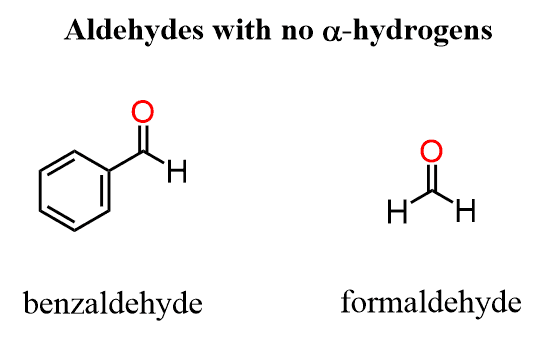In the previous post, we talked about the aldol reaction which occurs when an aldehyde is treated with a base. The role of the base here is to deprotonate the ɑ position of the aldehyde and thus convert it into a nucleophile which subsequently attack the electrophile carbon of another aldehyde molecule. Here is the mechanism of the aldol reaction:

Now, what happens if we add a base to an aldehyde does not have ɑ hydrogens? For example, benzaldehyde or formaldehyde:

It turns out, in this case, the aldehyde is converted into an alcohol and a carboxylic acid.

We know that converting an aldehyde into an alcohol is a reduction, while going from an aldehyde to a carboxylic acid is an oxidation reaction. So, we can say that half of the aldehyde is oxidized and half of it is reduced. Therefore, in summary, the Cannizzaro reaction is a base-catalyzed disproportionation of aldehydes that have no ɑ-hydrogens.
The Mechanism of Cannizzaro Reaction
To understand the canizzarro reaction, remember, from the reactions of aldehydes and ketones, that the carbonyl carbon is very electrophilic and undergoes a variety of nucleophilic addition reactions. For example, aldehydes and ketones can be transformed into hydrates when reacted with water under acid or basic conditions.
Since our focus today is the Cannizzaro reaction, which is catalyzed by a strong base, let’s recall what happens when an aldehyde is dissolved in an aqueous base media.

In the first step, the –OH attacks the carbonyl carbon, cleaving the π bond, and moving an electron pair onto oxygen. This forms a negatively charged intermediate which, upon protonation by water results in a geminal diol.
Now, the Cannizzaro reaction is starts just like this nucleophilic addition, however, the intermediate undergoes an intermolecular hydride transfer:

All the steps in the Cannizzaro reaction look nothing out of ordinary and only the hydride shift may raise the question of why that would happen.
To answer that, let’s recall that the dianion intermediate is very unstable because of the strong electron-donating character of the negatively charged oxygens. There is simply too much electron density around the carbon in the tetrahedral intermediate and it has to lose one of the groups to release this tension. So, we need to consider the leaving ability of those groups connected to the carbon.
Which one, out of O2–, R–, and H–, do you think is a better leaving group?
The truth is none of them is particularly good leaving group. In fact, they are all quite awful to be released in a solution. However, if there is an electrophilic center nearby, the hydride may reluctantly break from the carbon and shift to this center. And this center happens to be the carbonyl carbon of another benzaldehyde molecule.
As expected, the hydride shift is very slow and therefore is the rate determining step of the Cannizzaro reaction.
Crossed-Cannizzaro Reaction
When the Cannizzaro reaction is carried out using two different aldehydes, it is called a crossed-Cannizzaro reaction.
An important crossed Cannizzaro reaction is when formaldehyde is used as it is normally more reactive towards nucleophiles than other aldehydes. The reason for this higher reactivity is that it has a more electrophilic carbon since there are no electron donating alkyl groups and also the tetrahedral intermediate resulting from the nucleophilic addition is not as sterically hindered.
That is why, unlike acetone, formaldehyde exists mainly as a hydrate in aqueous solutions:

So, what is the advantage of using formaldehyde in the Cannizzaro reaction?
Well, if it is going to be attacked by the hydroxide ion and converted in to an unstable diion intermediate, then it is also going to be the main donor if the hydride ion. So, it will reduce the other aldehyde to an alcohol and as a result will be oxidized into formic acid.
This approach then can be used to increase the yield of the alcohol which is normally 50% : 50% with the acid.
Check Also
- Alpha Halogenation of Enols and Enolates
- The Haloform and Iodoform Reactions
- Alpha Halogenation of Carboxylic Acids
- Alpha Halogenation of Enols and Enolates Practice Problems
- Aldol Reaction – Principles and Mechanism
- Aldol Condensation – Dehydration of Aldol Addition Product
- Intramolecular Aldol Reactions
- Aldol Addition and Condensation Reactions – Practice Problems
- Crossed Aldol And Directed Aldol Reactions
- Crossed Aldol Condensation Practice Problems
- Alkylation of Enolates Alpha Position
- Enolate Alkylation Practice Problems
- Acetoacetic Ester Synthesis
- Acetoacetic Ester Enolates Practice Problems
- Malonic Ester Synthesis
- Michael Reaction: The Conjugate Addition of Enolates
- Robinson Annulation, Shortcut, and Retrosynthesis
- Claisen Condensation
- Dieckmann condensation – An Intramolecular Claisen Reaction
- Crossed Claisen and Claisen Variation Reactions
- Claisen Condensation Practice Problems
- Stork Enamine Synthesis
- Enolates in Organic Synthesis – a Comprehensive Practice Problem

Great explanation
Thanx